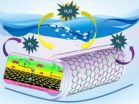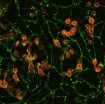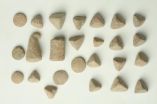(Press-News.org) The Roquin protein, discovered in 2005, controls T-cell activation and differentiation by regulating the expression of certain mRNAs. In doing so, it helps to guarantee immunological tolerance and prevents immune responses against the body's own structures that can lead to autoimmune disease. Roquin is thus an immune regulator. Autoimmune diseases affect between five and ten per cent of the population. They usually occur as a result of complex environmental influences when a genetic predisposition exists. Only in rare cases the development of the disease is determined by a single mutated gene. However, a single mutation in the Roquin gene in a mouse model was shown to be responsible for the development of the autoimmune disease systemic lupus erythematosus. This mutation in the Roquin protein also led to a high susceptibility to type 1 diabetes and rheumatoid arthritis and induced angioimmunoblastic T-cell lymphoma.
Elucidation of the three-dimensional structure of the Roquin-RNA complex
An interdisciplinary team comprising the research groups led by Prof. Michael Sattler, Dr. Dierk Niessing and Prof. Vigo Heissmeyer at the Helmholtz Zentrum München, Ludwig-Maximilian University (LMU) and the Technische Universität München (TUM) has now revealed unprecedented insight into how Roquin recognizes its RNA binding partner and thereby controls T-cell functions. To this end, the scientists Dr. Andreas Schlundt, Gitta Heinz, and Dr. Robert Janowski used the X-ray crystallography platform of the Helmholtz Zentrum München to determine the spatial structure of the RNA binding domain of Roquin when bound to its RNA target. The interaction of Roquin with additional RNA binding partners was studied in solution using nuclear magnetic resonance (NMR) spectroscopy at the Bavarian NMR Center, a joint research infrastructure of the Helmholtz Zentrum München and TUM. Furthermore, the researchers could confirm the biological significance of the molecular recognition of the RNA by studying Roquin-dependent gene regulation in cellular systems.
The results obtained reveal for the first time the molecular interactions with which roquin recognizes a binding motif in a gene's mRNA. "To our surprise, these results indicate that a greater range of binding modes plays an important functional role for the gene regulation in T-cells," says Prof. Michael Sattler. "Thus, our findings suggest that Roquin regulates a larger number of genes than was previously assumed," Dr. Niessing adds. In addition to the mRNAs with optimal recognition motifs, which are tightly bound and predominantly regulated by Roquin, there is a potentially much larger number of mRNAs which are more weakly bound, but nevertheless regulated by Roquin. "On the basis of these findings we will now focus on understanding how Roquin levels are regulated in T-cells, since strong and weakly bound target mRNAs will experience a principally different regulation when the availability of the protein varies" explains Prof. Vigo Heissmeyer.
Basis for developing treatment
Defining the molecular interplay between Roquin and RNA is a prerequisite for con-trolling the function of Roquin and using its role for therapeutic strategies to treat autoimmune diseases. To this end, the scientists are now planning follow-up studies to find out how the function of Roquin can be manipulated.
INFORMATION:
Further information
Background
*Autoimmune diseases occur when the immune system is activated to launch a response against normal body tissues and to treat them like a pathogen. In the process, the tissue is then damaged or destroyed, In the case of Type 1 diabetes, for example, an immune reaction is triggered to attack the insulin-producing cells in the pancreas. In the case of lupus, almost any part of the body can be attacked by the immune system.
Original publication:
Schlundt A. et al. (2014). Structural basis for RNA recognition in roquin-mediated post-transcriptional gene regulation, Nat Struct Mol Biol nähere Angaben bitte noch einfügen, doi:10.1038/nsmb.2855
Link to publication: http://www.nature.com/nsmb/journal/vaop/ncurrent/full/nsmb.2855.html
The Helmholtz Zentrum München the German Research Center for Environmental Health, pursues the goal of developing personalized medical approaches to the prevention and therapy of major common diseases such as diabetes and lung diseases. To achieve this, it investigates the interaction of genetics, environmental factors and lifestyle. The Helmholtz Zentrum München has about 2,200 staff members and is headquartered in Neuherberg in the north of Munich. It is a member of the Helmholtz Association, a community of 18 scientific-technical and medical-biological research centers with a total of about 34,000 staff members. http://www.helmholtz-muenchen.de/en/index.html
Institute for Structural Biology (STB) investigates the spatial structures of biological macromolecules, their molecular interactions and dynamics using integrated structural biology by combining X-ray crystallography, NMR-spectroscopy and other methods. Researchers at STB also develop NMR spectroscopy methods for these studies. The goal is to unravel the structural and molecular mechanisms underlying biological function and their impairment in disease. The structural information is used for the rational design and development of small molecular inhibitors in combination with chemical biology approaches. http://www.helmholtz-muenchen.de/en/stb/index.html
Media contacts
Communications Dept., Helmholtz Zentrum München – Deutsches Forschungszentrum für Gesundheit und Umwelt (GmbH), Ingolstaedter Landstr. 1, D-85764 Neuherberg - Tel.: +49 89-3187-2238 - Fax: +49 89-3187-3324 - e-mail: presse@helmholtz-muenchen.de
Specialist contacts
Vigo Heissmeyer,Dept. of Molecular Immune Regulation, Institute of Molecular Immunology, Tel.: +49 89 3187 1214, Fax: +49 89 3187-1300, e-mail: vigo.heissmeyer@helmholtz-muenchen.de
Dierk Niessing, Intracellular Transport and RNA Biology Group, Institute for Structural Biology, Tel.: +49 89 3187-2176, e-mail: niessing@helmholtz-muenchen.de
Michael Sattler, Institute for Structural Biology, Tel: +49 89 3187-3800, Fax: +49 89 28913869, e-mail: sattler@helmholtz-muenchen.de
Helmholtz Zentrum München - Deutsches Forschungszentrum für Gesundheit und Umwelt (GmbH), Ingolstaedter Landstr. 1, D-85764 Neuherberg
Molecular mechanisms underlying the prevention of autoim-munity by Roquin revealed
2014-07-14
ELSE PRESS RELEASES FROM THIS DATE:
Flower development in 3D: Timing is the key
2014-07-14
In close collaboration with Jürg Schönenberger and Yannick Städler from the Department of Botany and Biodiversity Research of the Faculty of Life Sciences, University of Vienna, 14 developmental stages of the flower of Arabidopsis thaliana from very early meristematic floral initiation to fully developed seeds were monitored with micro-computed tomography in 3D. From the same set of developmental stages a full metabolic profile using mass spectrometry was measured covering hundreds of biochemical pathways.
"Smallest changes in floral organ development were thus correlated ...
A-maize-ing double life of a genome
2014-07-14
Early maize farmers selected for genes that improved the harvesting of sunlight, a new detailed study of how plants use 'doubles' of their genomes reveals. The findings could help current efforts to improve existing crop varieties.
Oxford University researchers captured a 'genetic snapshot' of maize as it existed 10 million years ago when the plant made a double of its genome – a 'whole genome duplication' event. They then traced how maize evolved to use these 'copied' genes to cope with the pressures of domestication, which began around 12,000 years ago. They discovered ...
Rutgers chemists develop technology to produce clean-burning hydrogen fuel
2014-07-14
Rutgers researchers have developed a technology that could overcome a major cost barrier to make clean-burning hydrogen fuel – a fuel that could replace expensive and environmentally harmful fossil fuels.
The new technology is a novel catalyst that performs almost as well as cost-prohibitive platinum for so-called electrolysis reactions, which use electric currents to split water molecules into hydrogen and oxygen. The Rutgers technology is also far more efficient than less-expensive catalysts investigated to-date.
"Hydrogen has long been expected to play a vital role ...
Wisconsin scientists find genetic recipe to turn stem cells to blood
2014-07-14
MADISON, Wis. — The ability to reliably and safely make in the laboratory all of the different types of cells in human blood is one key step closer to reality.
Writing today in the journal Nature Communications, a group led by University of Wisconsin-Madison stem cell researcher Igor Slukvin reports the discovery of two genetic programs responsible for taking blank-slate stem cells and turning them into both red and the array of white cells that make up human blood.
The research is important because it identifies how nature itself makes blood products at the earliest ...
Testicular cancer rates are on the rise in young Hispanic Americans
2014-07-14
A new analysis has found that rates of testicular cancer have been rising dramatically in recent years among young Hispanic American men, but not among their non-Hispanic counterparts. Published early online in Cancer, a peer-reviewed journal of the American Cancer Society, the findings indicate that greater awareness is needed concerning the increasing risk of testicular cancer in Hispanic adolescents and young adults, and that research efforts are needed to determine the cause of this trend.
Testicular cancer is one of the most common types of cancer among adolescent ...
Potential Alzheimer's disease risk factor and risk reduction strategies become clearer
2014-07-14
COPENHAGEN – Participation in activities that promote mental activity, and moderate physical activity in middle age, may help protect against the development of Alzheimer's disease and dementia in later life, according to new research reported today at the Alzheimer's Association International Conference® 2014 (AAIC® 2014) in Copenhagen.
Research reported at AAIC 2014 also showed that sleep problems – especially when combined with post-traumatic stress disorder (PTSD) – may increase dementia risk in veterans. Additionally, in a population of people age 90 and older, ...
Weighty issue: Stress and high-fat meals combine to slow metabolism in women
2014-07-14
VIDEO:
Researchers at The Ohio State University Wexner Medical Center have found that women who ate a high-fat meal the day after a stressful event metabolized food more slowly, and the...
Click here for more information.
COLUMBUS, Ohio – A new study in women suggests that experiencing one or more stressful events the day before eating a single high-fat meal can slow the body's metabolism, potentially contributing to weight gain.
Researchers questioned study participants about ...
Prehistoric 'bookkeeping' continued long after invention of writing
2014-07-14
An archaeological dig in southeast Turkey has uncovered a large number of clay tokens that were used as records of trade until the advent of writing, or so it had been believed.
But the new find of tokens dates from a time when writing was commonplace – thousands of years after it was previously assumed this technology had become obsolete. Researchers compare it to the continued use of pens in the age of the word processor.
The tokens – small clay pieces in a range of simple shapes – are thought to have been used as a rudimentary bookkeeping system in prehistoric ...
The Lancet Neurology: Post-concussion 'return to play' decision for footballers should be made solely by doctors, says new editorial
2014-07-14
An editorial published today in The Lancet Neurology calls for sports authorities to take into consideration the long term neurological problems that repeated concussions can cause.
Cerebral concussion is the most common form of sports-related traumatic brain injury (TBI), and the long-term effects of repeated concussions may include dementia, amyotrophic lateral sclerosis, and other neurological disorders, say the journal editors.
However, what is perhaps more concerning, is that even when the symptoms of concussion are delayed, or if they come and go quickly, neurological ...
The Lancet Oncology: Differences in treatment likely to be behind differing survival rates for blood cancers between regions within Europe
2014-07-14
Failure to get the best treatment and variations in the quality of care are the most likely reasons why survival for blood cancer patients still varies widely between regions within Europe, according to the largest population-based study of survival in European adults to date, published in The Lancet Oncology.
"The good news is that 5-year survival for most cancers of the blood has increased over the past 11 years, most likely reflecting the approval of new targeted drugs in the early 2000s such as rituximab for non-Hodgkin lymphoma and imatinib for chronic myeloid leukaemia", ...




